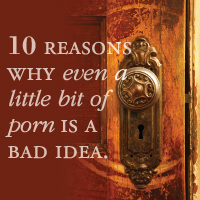Porn free, not free porn

The destructive ubiquitousness of porn: It is not a pleasant topic but we need to get serious about addressing the negative impact of pornography on our society and our relationships.
When the western world went into lockdown, one of the biggest porn providers made global headlines when it offered free porn for a month. When your business is based on the supply of an addictive (yes, it taps into the same biochemical pathways of some of our hardest drugs), destructive and largely unregulated product, it is deeply cynical to make it freely available to a world full of fear and in pandemic mayhem.
Nude Art and Porn are not the same
The human body is beautiful. The Sistine Chapel at the Vatican can display human nakedness on its ceiling and walls. But we all know artistic images of the body are a million miles from the pornography that fills the internet.
As one US senator said during an inquiry on pornography, “it may be difficult to define but you know it when you see it”.
The fundamental difference between the art in the Sistine Chapel and porn, is in the intent.
In the Sistine Chapel, Michelangelo used the human form to illustrate God’s creative genius, to express through the human body a theology of divine longing for human flourishing and communion.
As the viewer is drawn into the divine mystery, one is inspired towards deeper faith in the profound love of the creator; the naked human form retells the story of salvation and inspires humility before the wonder of God’s love and mercy.
In this way the body itself is ‘sacramental’ – it reveals in its physical aspects the invisible mystery of the divine.
Porn, on the other hand, seeks to incite lust in the viewer. The naked body is depersonalised and objectified to conceal the human dignity of the subject as the beloved creation of a loving God. It’s a lust that desires to possess the subject, to conquer it and subjugate it to the will of the viewer.
Where Michelangelo’s art turns the thoughts and aspirations outwards towards self-giving, porn turns the viewer’s thoughts and ambitions inwards, towards self-gratification.
In fact, it is common these days to talk about ‘consumers’ of porn, rather than viewers, for indeed, that is what porn encourages. The viewer ‘consumes’ the images, and in doing so, fundamentally changes one’s interior orientation.
Porn-driven behaviour
In a podcast interview of Jason Evert and Matt Fradd, two Catholic evangelists who speak regularly in schools on sexuality and porn, they noted how the subject of porn is now centre stage in discussions with youth. Whereas once, a small minority said that porn was affecting their attitudes or behaviour, now the majority of them of say it does.
These speakers say that kids line up for hours after their presentations to talk with them and the stories are heart breaking.
Another speaker on the topic recounted how a seventeen year-old Catholic school student, was being pressured to watch hard core porn with her boyfriend and then replicate the sex acts with him. Her question – “is this normal?” – left him gutted; these kids no longer know what is ‘normal’, let alone acceptable.
And unfortunately, now it’s not just something that afflicts the young and lonely. In our own work with married couples, even among ‘good’ married couples, porn is becoming normalised.
Created for more
God created our bodies with all its sexual functions and desires for a far higher purpose than simple physical pleasure. He embedded within us a desire for infinite joy. There’s really only one being who can meet our infinite longings – the infinite God who created us.
As human beings, we like to have clear rules. Unless we don’t like them. Then, we’d rather the rules be ‘open to interpretation’. When it comes to God’s commandments for our moral life it’s pretty clear on the use of pornography: It’s. Not. On.
Jesus said in the Sermon on the Mount: “You have heard that it was said, ‘You shall not commit adultery.’ But I tell you that anyone who looks at a woman lustfully has already committed adultery with her in his heart.” (Mt 5:27-28)
We just don’t see any wriggle room for interpretation on this one – Jesus is unambiguous. Although he doesn’t use the term ‘pornography’ explicitly, it’s clear that pornography is essentially ‘lusting after another’, and as such, it’s not ok – for everyone.
Men and women. Same-sex or other-sex attracted. Singles, married people, widows, and celibates. It’s simply never ok to lust after another person.
And it’s certainly not virtuous. We once had a husband justify to us that because his wife wasn’t sexually satisfying him, it was nobler for him to use porn than to use a prostitute or have an affair. This is akin to saying that beating my wife is better than killing her; the attitude behind the premise is fundamentally twisted.
Sexual satisfaction isn’t an entitlement. It isn’t something we are ‘owed’ or have earned. Our bodies and sexual desires are intended to be given away in service and in love for the good of another. Everything about healthy sexual intimacy involves being a gift.
That’s why sexual union is reserved exclusively for marriage, for only in the context of a permanent, life-long commitment to love and serve our spouse with complete dedication is there any hope that we might overcome our inclination to lust and self-gratification.
To be sure, even within marriage, it’s a constant battle between the impulse to lust and the call to love. Getting married is not a magic fix that somehow overnight transforms our lust into virtue; it’s a constant human struggle to die to our selfish desires and is really what Jesus was getting at when he called his followers to ‘take up your cross daily and follow me’. (see Lk 9:23).
The Porn Free Movement
But what to do? How do we tackle this mammoth demon?
We are so excited about a new online enterprise. Initiated by Paul Ninnes and Joseph Thorley (two Brisbane Catholics), the Porn Free Movement is a collaborative effort by people of various backgrounds united in their stand against porn.
The website (www.pornfreemovement.com) features links to sociological studies demonstrating the harm of porn, embedded videos from global experts, testimonies from those who have been harmed by porn and those who have overcome their addiction.
Importantly, it also includes links to resources, counsellors, support groups and online programs all with the goal of helping people go #pornfree. It’s not just another website – it’s a coordination platform for a movement.
Everyone is a victim when it comes to porn and people become trapped in their shame and locked in the darkness. This initiative is about caring enough for our friends and loved ones to address the darkness – firstly in ourselves, and then in others and in the culture.
Whether we are directly impacted by porn or are one of the few who are untouched by it, it’s time to get behind this movement.
Visit the website, find it on social media, like it and share it.
Get professional help if needed.
Have those awkward conversations with our loved ones.
And pray like crazy. This is a spiritual battle and it will take spiritual power to overcome it.
We say: Enough! Join with us and millions of others in pushing back against this organised assault on our marriages and our kids. Let’s reclaim the sexual integrity of our culture.




